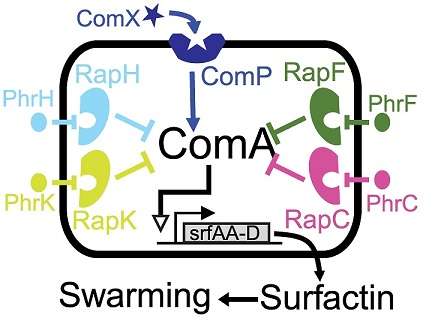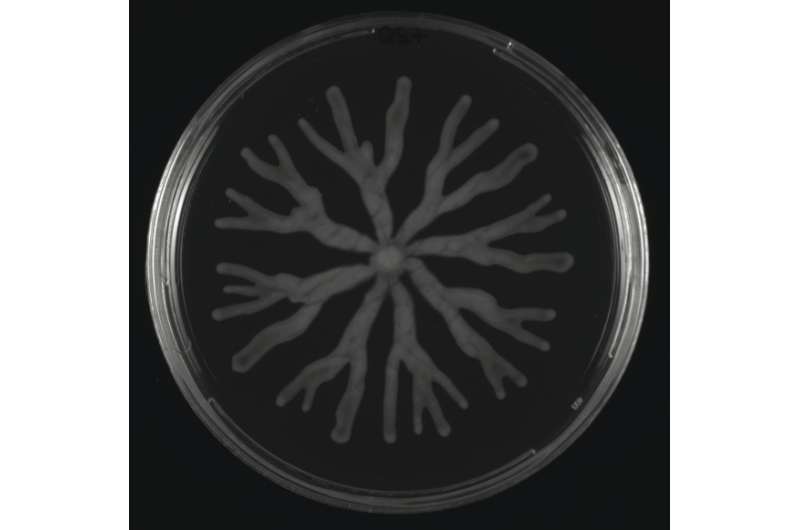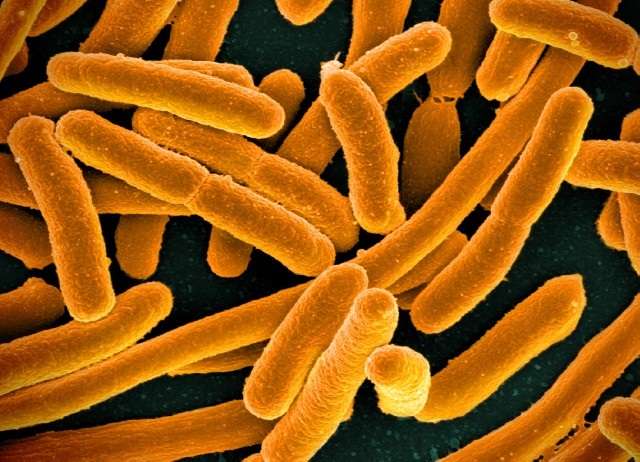Multiple receptors feed into the B. subtilis QS system. Credit: 10.1371/journal.pbio.1002386.g001
Perhaps when you think of bacterial communities you think of a flask full of rapidly dividing E. coli. But in non-lab conditions, bacteria grow in complex, heterogeneous communities composed of diverse microscopic organisms. In these communities, bacteria need a means to communicate with their kin, and they do this through a language known as quorum sensing (QS), where bugs secrete and detect factors that tell them whether they're surrounded by kin (and if so, how many there are).
Bacteria need this information if they produce "public good" metabolites that benefit the community. Not only are these costly for the individual bacterium to manufacture, but they require the cooperation of many bacteria to generate enough to be useful. QS can therefore tell bacteria whether it's worthwhile producing the public good. As with human social contracts, however, not all bacteria are interested in cooperating; some are cheaters, benefiting from the public good without contributing themselves. While this is to a certain extent tolerated, too many freeloaders in a population can result in a "tragedy of the commons," or depletion of the public good. Thus there's a delicate balance between cheaters and cooperators, with QS playing an important role.
One aspect of QS has long puzzled researchers; many species of bacteria seem have multiple QS pathways that each recognize a different factor with a specific receptor, but all these pathways funnel through the same regulator protein. These pathways thus seem redundant, begging the question as to why they would all be maintained during evolution. In a recent paper published in PLOS Biology, Eran Even-Tov, Shira Omer Bendori, Avigdor Eldar, and colleagues used a combination of experiments in two species of bacteria with multiple QS pathways (Bacillus subtilis and Vibrio harveyi) and mathematical modeling to investigate this question. Interestingly, they found that the acquisition of an extra QS pathway allowed the bacteria to become a "facultative cheater." This means that the strain with the extra pathway, when in low abundance, could cheat when grown in competition with the strain lacking the extra pathway. However, when the extra pathway strain was in high abundance, it reverted back to a cooperative mode. In this way, the extra QS pathway prevented the tragedy of the commons.
P. aeruginosa need iron-limitation and QS to swarm. Credit: 10.1371/journal.pcbi.1004279.g006
The choice of whether to cooperate or not is dependent on more than just surrounding community composition, however. A PLOS Computational Biology paper demonstrates that the bacterium Pseudomonas aeruginosa integrates information about both population size and metabolic resources to make the decision on whether to put energy into costly cooperative behaviors. Intriguingly, they found that limiting carbon source, nitrogen source, or iron each affected the production of the public good, rhamnolipids, differently, indicating a sophisticated consideration of both QS and nutrient signals.
The production of public goods is traditionally thought to come at a price to the individual, but a benefit to the community. However, a recent PLOS ONE paper shows that there may be some additional private benefit to those cells that cooperate and produce – on top of the community benefit. By constructing a synthetic QS pathway in Bacillus subtilis – a species that produces a protective extracellular matrix as its public good – they find that the cooperating strains are better able to respond to QS signals, and that the matrix appears to concentrate the QS molecules around the cooperating cells, potentially inducing an advantageous metabolic response. The costs and benefits of cooperation regulation via QS are also considered in a Frontiers in Microbiology paper, where the authors develop a model to determine how the optimal public good production rate depends on the population size.
As mentioned above, bacteria are part of diverse, heterogeneous, communities. Traditionally, QS is thought to be important only to interactions within a species, but a paper in PLOS Genetics shows that QS molecules in one species can affect the growth of another species. In this paper, the authors investigate a two-species system and determine the mechanisms that underlie the antagonism of P. aeruginosa against E. coli. They show that P. aeruginosa mutants deficient in a key QS pathway were less efficient in inhibiting the growth of E. coli, but also found that E. coli can evolve resistance to these QS molecules.
Considering the role of cooperation is important to more than just our understanding of general microbiology. Recent evidence shows that cooperation among pathogenic bacteria exists, contrary to the longstanding Independent Action Hypothesis. This hypothesis states that individual pathogens act independently of each other to increase the chance of establishing a successful infection. In this PLOS Pathogens paper, the authors provide direct evidence that the toxins secreted by the pathogen Bacillus thuringiensis have a synergistic effect on mortality. The invalidation of the Independent Action Hypothesis is important for developing improved mathematical risk-assessment models of a pathogen.
E. coli, shown here, were pitched against P. aeruginosa in a battle for QS supremacy. Credit: Niaid
More information: Eran Even-Tov et al. Social Evolution Selects for Redundancy in Bacterial Quorum Sensing, PLOS Biology (2016). DOI: 10.1371/journal.pbio.1002386
Kerry E. Boyle et al. Integration of Metabolic and Quorum Sensing Signals Governing the Decision to Cooperate in a Bacterial Social Trait, PLOS Computational Biology (2015). DOI: 10.1371/journal.pcbi.1004279
Fang Zhang et al. A Synthetic Quorum Sensing System Reveals a Potential Private Benefit for Public Good Production in a Biofilm, PLOS ONE (2015). DOI: 10.1371/journal.pone.0132948
Silja Heilmann et al. Why do bacteria regulate public goods by quorum sensing?â€"How the shapes of cost and benefit functions determine the form of optimal regulation, Frontiers in Microbiology (2015). DOI: 10.3389/fmicb.2015.00767
Anupama Khare et al. Multifactorial Competition and Resistance in a Two-Species Bacterial System, PLOS Genetics (2015). DOI: 10.1371/journal.pgen.1005715
Daniel M. Cornforth et al. Bacterial Cooperation Causes Systematic Errors in Pathogen Risk Assessment due to the Failure of the Independent Action Hypothesis, PLOS Pathogens (2015). DOI: 10.1371/journal.ppat.1004775
Journal information: PLoS Biology , PLoS ONE , PLoS Computational Biology , PLoS Genetics , PLoS Pathogens
Provided by Public Library of Science
This story is republished courtesy of PLOS Blogs: blogs.plos.org.
























